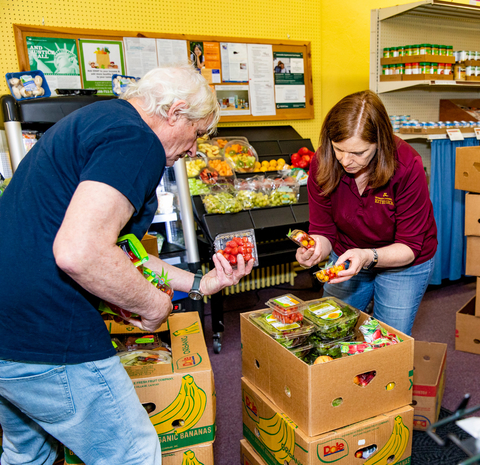Pipestone County Food Shelf has a faithful flock of volunteers—its board is made up of 16 local church leaders.
“Jack, who is in his 80s, unloads trucks, and Johnny carries groceries to cars,” says Lorelei Schelhaas, University of Minnesota Extension SNAP-Ed* educator. “Marv stocks shelves while several others pitch in. They all help where needed.”
There’s a reason Schelhaas knows the volunteers so well. She spent four months helping volunteer director Roger Raschke transform the food shelf into what’s become known as a SuperShelf. Nearly 40 SuperShelf transformations in every region of the state have created atmospheres that feel more welcoming and respectful to those in need.
Extension’s strength in the SuperShelf partnership comes from the experience educators like Schelhaas have in changing environments for better health—and doing so in ways that treat clients with dignity. SNAP-Ed educators work in every county with those who receive food assistance.
“Lorelei’s been indispensable, and the grants and SNAP-Ed funds allowed us to make it happen,” says Raschke.
Meeting family and community needs
The SuperShelf model fits any size of food shelf. The Catholic Charities Emergency Services Food Shelf in St. Cloud, for example, assists 6,000 clients each month, while the Wabasha Area Food Shelf serves 160.
They are both success stories.
Catholic Charities, with guidance from SNAP-Ed educators Dianne Davis-Kenning and Anna Sneltjes, has moved purchasing dollars that were going toward juice and ramen noodles toward more cooking ingredients. Wabasha was an early transformation, led by Annette Shepardson, Extension SNAP-Ed educator. They have found new sources for fresh fruits and vegetables. Clients want to cook healthy foods and love the changes.
Eye-catching and behavior-changing
The reality for many food shelves includes poor lighting, cast-off fixtures and old refrigeration cases, and food that looks less than appealing. They make do with donations and minimal funding, and with compassionate volunteers doing their best.
A SuperShelf transformation is bright and lively, but the purpose goes beyond looks. Fresh, colorful produce and whole-grains greet clients at the entrance. Schelhaas worked with the Midwest Dairy Council to provide a new dairy cooler and promote the idea of drinking milk instead of less-healthy beverages. Posters, shopping lists and layouts designed to promote the food groups also respectfully nudge clients toward healthy choices.
Evaluation running through 2021 will measure how SuperShelf strategies affect clients’ diet, food selections and cardiovascular health markers.
“It’s so fresh and clean. I like being able to choose for myself” – Pipestone County Food Shelf client
* Supplemental Nutrition Assistance Program Education
SuperShelf was founded as a partnership among The Food Group, Valley Outreach, HealthPartners, University of Minnesota Extension and University of Minnesota Department of Family Medicine and Community Health.



